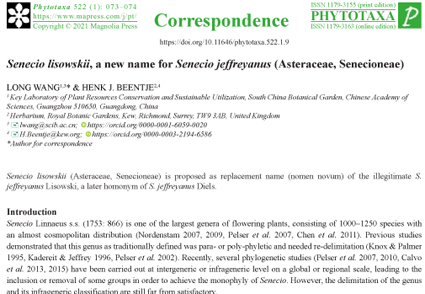Abstract
N/A
References
Beentje, H.J. (in press) Senecio L. In: Timberlake, J.R. & Martins, E.S. (eds.) Flora Zambesiaca, vol. 6 (4). Royal Botanic Garden, Kew, London.
Calvo, J., Álvarez, I. & Aedo, C. (2015) Systematics of Senecio section Crociseris (Compositae, Senecioneae). Phytotaxa 211: 1–105. https://doi.org/10.11646/phytotaxa.211.1.1
Calvo, J., Álvarez, I., Aedo, C. & Pelser, P.B. (2013) A phylogenetic analysis and new delimitation of Senecio sect. Crociseris (Compositae: Senecioneae), with evidence of intergeneric hybridization. Taxon 62: 127–140. https://doi.org/10.1002/tax.621011
Chen, Y.L., Nordenstam, B., Jeffrey, C. & Vincent, L. (2011) Senecio Linnaeus. In: Wu, Z.Y., Raven, P.H. & Hong, D.Y. (eds.) Flora of China, vol. 20–21. Science Press, Beijing & Missouri Botanical Garden Press, St. Louis, pp. 508–536.
Diels, F.L.E. (1912) Plantae Chinenses Forrestianae. New and imperfectly known species. Notes from the Royal Botanic Garden, Edinburgh 5: 161–308.
Kadereit, J.W. & Jeffrey, C. (1996) A preliminary analysis of cpDNA variation in the tribe Senecioneae (Compositae). In: Hind, D.J.N & Beentje, H.J. (eds.) Proceedings of the International Compositae Conference, Kew, 1994, vol. 1. Royal Botanic Gardens, Kew, pp. 349–360.
Knox, E.B. & Palmer, J.D. (1995) The origin of Dendrosenecio within the Senecioneae (Asteraceae) based on plastid DNA evidence. American Journal of Botany 82: 1567–1573. https://doi.org/10.3732/ajb.89.6.929
Linnaeus, C. (1753) Species Plantarum. Laurentius Salvius, Holmiae, 1200 pp.
Lisowski, S. (1991) Les Asteraceae dans la flore d’Afrique Centrale (excl. Cichorieae, Inuleae and Vernonieae), vol. 2. Fragmenta Floristica et Geobotanica 36 (1) (Suppl. 1): 251–627.
Nordenstam, B. (2007) Tribe Senecioneae Cass. In: Kadereit, J.W. & Jeffrey, C. (eds.) The Families and Genera of Vascular Plants, vol. 8. Springer, Berlin, pp. 208–242.
Nordenstam, B., Pelser, P.B., Kadereit, J.W. & Watson, L.E. (2009) Senecioneae. In: Funk, V.A., Susanna, A., Stussey, T.F. & Bayer, R.J. (eds.) Systematics, Evolution, and Biogeography of Compositae. International Association for Plant Taxonomy, Vienna, pp. 503–525.
Pelser, P.B., Gravendeel, B. & van der Meijden, R. (2002) Tackling speciose genera: species composition and phylogenetic position of Senecio sect. Jacobaea (Asteraceae) based on plastid and nrDNA sequences. American Journal of Botany 89: 929–939. https://doi.org/10.3732/ajb.89.6.929
Pelser, P.B., Nordenstam, B., Kadereit, J.W. & Watson, L.E. (2007) An ITS phylogeny of tribe Senecioneae (Asteraceae) and a new delimitation of Senecio L. Taxon 56: 1077–1104. https://doi.org/10.2307/25065905
Pelser, P.B., Tepe, E.J., Kennedy, A.H. & Watson, L.E. (2010) The fate of Robinsonia (Asteraeae): sunk in Senecio, but still monophyletic? Phytotaxa 5: 31–46. https://doi.org/10.11646/phytotaxa.5.1.2
Turland, N.J., Wiersema, J.H., Barrie, F.R., Greuter, W., Hawksworth, D.L., Herendeen, P.S., Knapp, S., Kusber, W.-H., Li, D.-Z., Marhold, K., May, T.W., McNeill, J., Monro, A.M., Prado, J., Price, M.J. & Smith, G.F. (2018) International Code of Nomenclature for algae, fungi, and plants (Shenzhen Code) adopted by the Nineteenth International Botanical Congress Shenzhen, China, July 2017. Regnum Vegetabile 159: 1–254. https://doi.org/10.12705/Code.2018
Calvo, J., Álvarez, I. & Aedo, C. (2015) Systematics of Senecio section Crociseris (Compositae, Senecioneae). Phytotaxa 211: 1–105. https://doi.org/10.11646/phytotaxa.211.1.1
Calvo, J., Álvarez, I., Aedo, C. & Pelser, P.B. (2013) A phylogenetic analysis and new delimitation of Senecio sect. Crociseris (Compositae: Senecioneae), with evidence of intergeneric hybridization. Taxon 62: 127–140. https://doi.org/10.1002/tax.621011
Chen, Y.L., Nordenstam, B., Jeffrey, C. & Vincent, L. (2011) Senecio Linnaeus. In: Wu, Z.Y., Raven, P.H. & Hong, D.Y. (eds.) Flora of China, vol. 20–21. Science Press, Beijing & Missouri Botanical Garden Press, St. Louis, pp. 508–536.
Diels, F.L.E. (1912) Plantae Chinenses Forrestianae. New and imperfectly known species. Notes from the Royal Botanic Garden, Edinburgh 5: 161–308.
Kadereit, J.W. & Jeffrey, C. (1996) A preliminary analysis of cpDNA variation in the tribe Senecioneae (Compositae). In: Hind, D.J.N & Beentje, H.J. (eds.) Proceedings of the International Compositae Conference, Kew, 1994, vol. 1. Royal Botanic Gardens, Kew, pp. 349–360.
Knox, E.B. & Palmer, J.D. (1995) The origin of Dendrosenecio within the Senecioneae (Asteraceae) based on plastid DNA evidence. American Journal of Botany 82: 1567–1573. https://doi.org/10.3732/ajb.89.6.929
Linnaeus, C. (1753) Species Plantarum. Laurentius Salvius, Holmiae, 1200 pp.
Lisowski, S. (1991) Les Asteraceae dans la flore d’Afrique Centrale (excl. Cichorieae, Inuleae and Vernonieae), vol. 2. Fragmenta Floristica et Geobotanica 36 (1) (Suppl. 1): 251–627.
Nordenstam, B. (2007) Tribe Senecioneae Cass. In: Kadereit, J.W. & Jeffrey, C. (eds.) The Families and Genera of Vascular Plants, vol. 8. Springer, Berlin, pp. 208–242.
Nordenstam, B., Pelser, P.B., Kadereit, J.W. & Watson, L.E. (2009) Senecioneae. In: Funk, V.A., Susanna, A., Stussey, T.F. & Bayer, R.J. (eds.) Systematics, Evolution, and Biogeography of Compositae. International Association for Plant Taxonomy, Vienna, pp. 503–525.
Pelser, P.B., Gravendeel, B. & van der Meijden, R. (2002) Tackling speciose genera: species composition and phylogenetic position of Senecio sect. Jacobaea (Asteraceae) based on plastid and nrDNA sequences. American Journal of Botany 89: 929–939. https://doi.org/10.3732/ajb.89.6.929
Pelser, P.B., Nordenstam, B., Kadereit, J.W. & Watson, L.E. (2007) An ITS phylogeny of tribe Senecioneae (Asteraceae) and a new delimitation of Senecio L. Taxon 56: 1077–1104. https://doi.org/10.2307/25065905
Pelser, P.B., Tepe, E.J., Kennedy, A.H. & Watson, L.E. (2010) The fate of Robinsonia (Asteraeae): sunk in Senecio, but still monophyletic? Phytotaxa 5: 31–46. https://doi.org/10.11646/phytotaxa.5.1.2
Turland, N.J., Wiersema, J.H., Barrie, F.R., Greuter, W., Hawksworth, D.L., Herendeen, P.S., Knapp, S., Kusber, W.-H., Li, D.-Z., Marhold, K., May, T.W., McNeill, J., Monro, A.M., Prado, J., Price, M.J. & Smith, G.F. (2018) International Code of Nomenclature for algae, fungi, and plants (Shenzhen Code) adopted by the Nineteenth International Botanical Congress Shenzhen, China, July 2017. Regnum Vegetabile 159: 1–254. https://doi.org/10.12705/Code.2018


